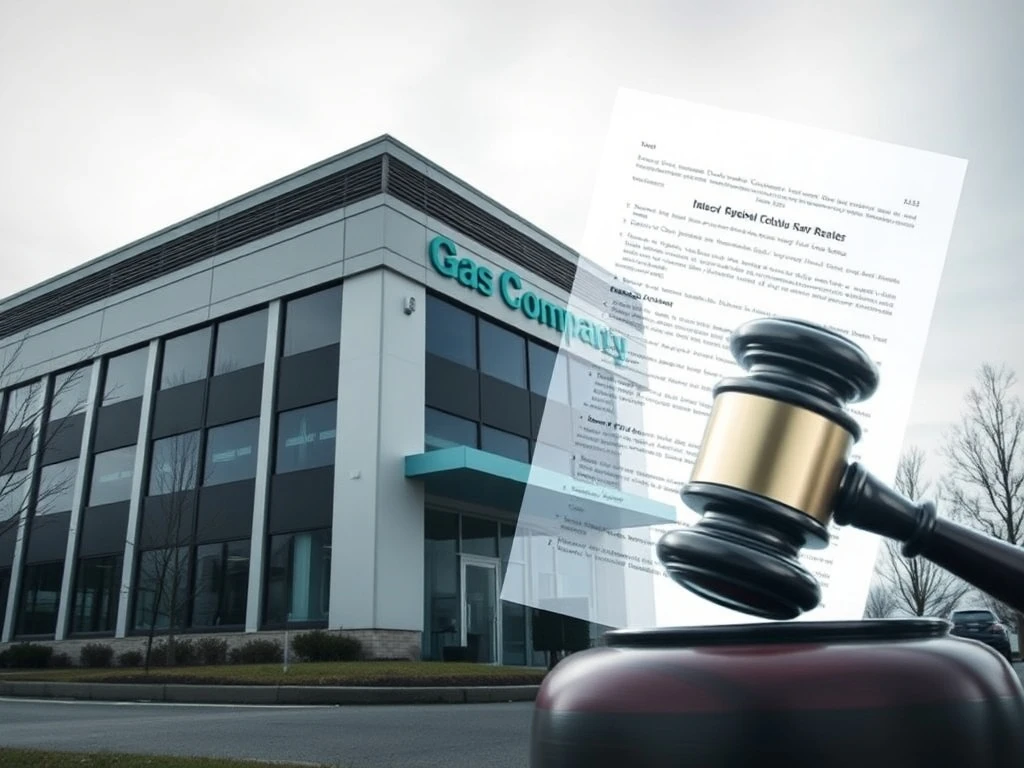The energy sector faces a significant development. Recently, a prominent, independent gas company, “Evergreen Energy Solutions,” has officially filed for Chapter 11 bankruptcy protection. This move marks a critical moment for the firm. It also raises questions across the broader energy landscape. Stakeholders are now closely watching the unfolding situation. The **gas company bankruptcy** filing highlights ongoing challenges within the industry. This unexpected turn of events could have far-reaching implications. Many are seeking to understand the full scope of its impact.
Understanding the **Gas Company Bankruptcy** Filing
Evergreen Energy Solutions, a company known for its innovative approach to natural gas extraction and distribution, initiated Chapter 11 proceedings. This decision came after a period of intense financial strain. The company cited several factors contributing to its distress. Primarily, a sustained downturn in natural gas prices severely impacted its revenue streams. Furthermore, substantial debt obligations from previous expansion projects became unmanageable. The company also faced increasing operational costs. These included regulatory compliance and environmental initiatives. Consequently, its liquidity dwindled significantly. This led directly to the bankruptcy filing. The filing occurred in the U.S. Bankruptcy Court for the District of Delaware. Court documents outline the company’s assets and liabilities. They also detail its proposed reorganization plan. This plan aims to restructure debt and continue operations. However, the path ahead remains complex.
Key reasons for Evergreen Energy Solutions’ financial difficulties include:
- Volatile Commodity Prices: Natural gas prices experienced significant fluctuations. This directly affected profitability.
- High Debt Load: Aggressive expansion strategies led to substantial borrowing. This created a heavy burden.
- Increased Regulatory Costs: Stricter environmental regulations added to operational expenses.
- Supply Chain Disruptions: Recent global events impacted equipment and service availability.
This **gas company bankruptcy** underscores the inherent risks in the energy sector. Companies must navigate complex market dynamics. They also face evolving regulatory environments. Evergreen Energy Solutions’ situation serves as a stark reminder. Financial prudence is always paramount.
The Chapter 11 Process: Navigating **Gas Company Bankruptcy**
Chapter 11 bankruptcy is a legal process. It allows companies to reorganize their business. This process provides a debtor with a fresh start. Crucially, it protects the company from creditors’ demands. While under Chapter 11, Evergreen Energy Solutions can continue its operations. It will do so under court supervision. The primary goal is to develop a viable reorganization plan. This plan must address how the company will repay its debts over time. It typically involves negotiations with creditors. The court must approve the final plan. This ensures fairness to all parties. The company retains control of its assets. However, significant decisions require court approval. This oversight is designed to protect stakeholder interests. Therefore, transparency becomes key during this period.
The Chapter 11 process typically involves several stages:
- Filing the Petition: The company submits formal documents to the bankruptcy court.
- Automatic Stay: Creditors are immediately prevented from pursuing collection actions.
- Debtor-in-Possession (DIP): The company’s management continues to operate the business. They act as fiduciaries for creditors.
- Formulating a Plan: The company proposes a reorganization plan. This details how debts will be paid.
- Creditor Voting and Court Confirmation: Creditors vote on the plan. The court then confirms it.
This structured approach offers a lifeline. It allows struggling businesses to avoid liquidation. For Evergreen Energy Solutions, it offers a chance to emerge stronger. The outcome will largely depend on the proposed plan’s feasibility. It also depends on creditor cooperation. This specific **gas company bankruptcy** filing will test these aspects.
Impact on Stakeholders and the Energy Market Following **Gas Company Bankruptcy**
The **gas company bankruptcy** of Evergreen Energy Solutions sends ripples throughout the energy market. Various stakeholders feel the immediate effects. Creditors, including banks and bondholders, face potential losses. Their ability to recover investments hinges on the reorganization plan. Employees, too, face uncertainty regarding job security. While Chapter 11 aims to preserve jobs, restructuring often involves workforce adjustments. Furthermore, consumers might experience indirect impacts. This could include shifts in local gas supply dynamics or price volatility. However, the direct impact on retail gas prices may be limited. This is due to the vastness of the global energy market. Nevertheless, the news can affect investor confidence. It might also influence lending practices within the energy sector. Other independent energy firms may find it harder to secure financing. This could lead to broader industry consolidation. Overall, the situation highlights market sensitivities. It shows how a single large filing can resonate.
Key impacts include:
- Creditors: Banks, suppliers, and bondholders may face reduced recoveries.
- Employees: Job security concerns and potential workforce reductions.
- Local Economies: Possible effects on regional employment and tax revenues.
- Competitors: May see opportunities or increased scrutiny from lenders.
- Market Confidence: Could cause investors to reassess risk in the energy sector.
The broader energy market watches closely. This **gas company bankruptcy** could set precedents. It might influence how similar financial challenges are addressed. Moreover, it underscores the ongoing need for robust risk management strategies within the industry.
Factors Contributing to Broader Energy Sector Distress
Evergreen Energy Solutions’ bankruptcy is not an isolated incident. The broader energy sector has faced significant headwinds recently. Global geopolitical tensions have contributed to market instability. Supply chain disruptions, exacerbated by recent events, have driven up costs. Furthermore, the push towards renewable energy sources introduces new competitive pressures. Many traditional fossil fuel companies are adapting. However, this transition requires substantial investment. It also presents operational challenges. Fluctuating demand patterns, partly due to economic slowdowns, also play a role. These macro factors create a challenging environment. Companies must innovate constantly. They also need to manage financial risks carefully. The cumulative effect of these pressures has led to distress for many firms. Therefore, Evergreen Energy Solutions’ filing is symptomatic of wider industry trends. This **gas company bankruptcy** reflects these systemic pressures. It emphasizes the need for resilience and strategic foresight.
Contributing factors to energy sector challenges:
- Geopolitical Volatility: Conflicts and policy shifts impact global energy supply and demand.
- Supply Chain Fragility: Disruptions lead to higher costs and delays in operations.
- Energy Transition: The shift to renewables pressures traditional fossil fuel models.
- Economic Slowdowns: Reduced industrial activity lowers energy demand.
- Capital Access: Lenders are becoming more cautious with energy sector investments.
These challenges demand adaptive strategies. Energy companies must prioritize efficiency. They also need to diversify revenue streams. The current environment necessitates careful financial planning. It also requires a proactive approach to market changes. The **gas company bankruptcy** highlights these critical needs.
Looking Ahead: The Path Post-**Gas Company Bankruptcy** Filing
The immediate future for Evergreen Energy Solutions involves intensive work. The company must now negotiate with its creditors. Its goal is to gain approval for a viable reorganization plan. This process can be lengthy. It often takes months, sometimes even years. During this period, the company will focus on operational efficiency. It will also seek to stabilize its financial position. Asset sales might be considered. Debt-for-equity swaps are another possibility. The aim is always to reduce the debt burden. Successfully emerging from Chapter 11 means the company can continue operating. It will do so with a healthier balance sheet. However, failure to gain approval could lead to liquidation. This would involve selling off assets to pay creditors. The outcome for this particular **gas company bankruptcy** will depend on many factors. These include market conditions and stakeholder cooperation. Industry observers will closely monitor its progress. The lessons learned could shape future strategies for other energy firms.
Potential outcomes for Evergreen Energy Solutions:
- Successful Reorganization: Emergence as a leaner, more financially stable entity.
- Asset Sales: Divestiture of non-core assets to raise capital.
- Debt-for-Equity Swaps: Creditors convert debt into ownership stakes.
- Liquidation: If reorganization fails, assets are sold to repay creditors.
The path forward is challenging. Nevertheless, Chapter 11 offers a structured framework for recovery. This **gas company bankruptcy** serves as a case study. It illustrates the complexities of corporate restructuring within a vital industry.
The filing of Chapter 11 by Evergreen Energy Solutions marks a significant event. It underscores the inherent volatility of the energy sector. It also highlights the financial pressures faced by even established firms. While challenging, the Chapter 11 process offers a structured path. It allows for potential recovery and restructuring. The outcome will undoubtedly impact numerous stakeholders. It will also provide valuable insights for the broader industry. As the situation unfolds, continuous monitoring will be essential. This **gas company bankruptcy** story is far from over. It will continue to shape discussions about energy market resilience and corporate finance strategies.
Frequently Asked Questions (FAQs) About **Gas Company Bankruptcy**
1. What does Chapter 11 bankruptcy mean for a gas company?
Chapter 11 bankruptcy allows a gas company to reorganize its business affairs, debts, and assets under the protection of the bankruptcy court. It typically permits the company to continue operating while it develops a plan to repay its creditors over time, rather than liquidating its assets immediately.
2. Why did Evergreen Energy Solutions file for Chapter 11?
Evergreen Energy Solutions cited several factors for its filing, including a sustained downturn in natural gas prices, significant debt obligations from past expansion, and rising operational costs, including regulatory compliance. These factors collectively led to severe financial strain and liquidity issues.
3. How does this **gas company bankruptcy** affect consumers?
The direct impact on consumers is generally limited. The global nature of the energy market means that one company’s bankruptcy may not significantly affect retail gas prices or supply for most consumers. However, local supply dynamics could see minor shifts, and investor confidence in the sector might be affected.
4. What happens to the employees of a company in Chapter 11?
While Chapter 11 aims to preserve jobs, employees often face uncertainty. The company continues operations, but restructuring efforts may involve workforce adjustments, including layoffs, as part of the plan to reduce costs and achieve financial stability. Employees’ benefits and pensions are subject to the reorganization plan.
5. What are the next steps for Evergreen Energy Solutions?
Evergreen Energy Solutions must now negotiate with its creditors to propose a reorganization plan. This plan details how the company intends to repay its debts and restructure its operations. The plan requires approval from creditors and confirmation by the bankruptcy court. The process can take several months or even years.
6. Could this **gas company bankruptcy** affect other energy companies?
Yes, such a significant filing can affect other energy companies. It might lead to increased scrutiny from lenders, making it harder for other firms to secure financing. It could also influence market confidence, potentially affecting stock prices of similar companies. Furthermore, it highlights broader industry challenges, prompting competitors to reassess their own risk management strategies.














